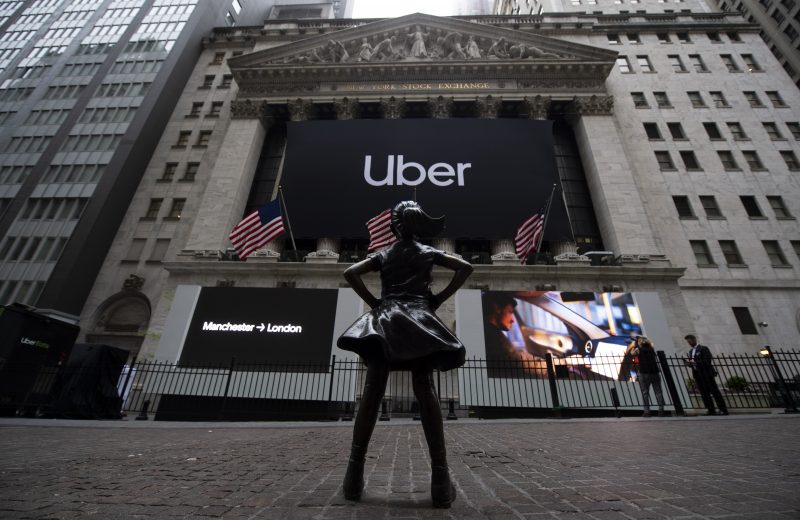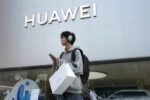Uber skids in milestone Wall Street debut
The “Fearless Girl” statue, by sculptor Kristen Visbal, stands outside the New York Stock Exchange (NYSE) ahead of the market debut for ride-hailing firm Uber (Johannes EISELE)
New York (AFP) – Uber shares skidded in their first trades on Wall Street Friday after a hotly anticipated public offering from the global ride-hailing giant.
After pricing at $45 for the initial public offering — translating to a market value of $82 billion — Uber fell to $42.02 at the open on the New York Stock Exchange, a drop of some six percent.
The decline, in a volatile session on Wall Street, was a disappointing start for a much-anticipated offering that is one of the biggest IPOs ever.
Chief executive Dara Khosrowshahi and an Uber team rang the opening bell on the New York Stock Exchange after the global ride-hailing giant raised some $8.1 billion in the IPO.
The drop at the opening was a “big disappointment” and suggested lower demand than expected for a major name like Uber, said Matt Kennedy, a strategist at Renaissance Capital.
Kennedy said that both Uber and US rideshare rival Lyft were lower on concerns about hefty losses at the ride-hailing services.
“I’ve mentioned how much money Uber is losing,” he said. “Silicon Valley may not care about losses, but Wall Street does.”
Despite the staggering valuation, Uber dialed back some of its earlier ambitions for a value exceeding $100 billion after a rocky start for Lyft, which went public in March.
While Uber has lost billions of dollars since launching its first rides in 2011 in San Francisco, the company is aiming to develop a global brand that helps transform local transportation.
Whether Uber can drive to profitability using this model as it disrupts traditional taxi and transport services is a key question.
Daniel Ives at Wedbush Securities was upbeat on Uber despite the weaker-than-anticipated valuation.
Ives said Uber has “established itself as the clear number one player in the ridesharing industry and is paving a similar road to what Amazon did to transform retail/ecommerce and Facebook did for social media.”
– Risks to business model –
But some of the risks surrounding Uber and its rivals were highlighted Wednesday as thousands of drivers turned off their apps in a US-wide strike over pay and working conditions.
The strikes targeting Uber and Lyft highlighted a dilemma for rideshare firms, which have faced challenges from regulators and traditional taxi operators for using a business model relying on independent contractors.
One group protested outside the New York Stock Exchange, some holding signs that read “Invest in our lives — Not their stocks.”
“While we aim to provide an earnings opportunity comparable to that available in retail, wholesale, or restaurant services or other similar work, we continue to experience dissatisfaction with our platform from a significant number of drivers,” Uber said in a filing with securities regulators.
Uber said in a securities filing Thursday that it had reached an agreement with a large majority of the roughly 60,000 drivers contesting their status as independent contractors and who had instituted arbitration proceedings against the firm.
The company anticipates the total cost of the individual settlements, combined with attorneys’ fees, will fall between $146 million and $170 million.
Uber maintained it was sticking to its plans on how it classifies drivers.
“Our business would be adversely affected if drivers were classified as employees instead of independent contractors,” the company said.
Uber’s IPO was underwritten by Goldman Sachs, Morgan Stanley, Bank of America Merrill Lynch and other large banks.
– Rocky debut for Lyft –
Uber’s inauguration as a public company will follow a rocky market debut for Lyft, which has lost more than 15 percent of its value since its March offering.
Lyft’s losses in the past quarter widened to $1.1 billion, according to its first financial report as a public company.
Uber envisions becoming the “Amazon of transportation” in a future where people share instead of owning vehicles.
If all goes to plan, commuters could ride an e-scooter to a transit station, take a train, then grab an e-bike or e-scooter to complete a journey using the Uber smartphone app.
Uber is also taking to the sky with an Elevate project to have electric aircraft carry people between “skyports,” taking off and landing vertically.
Disclaimer: Validity of the above story is for 7 Days from original date of publishing. Source: AFP.


